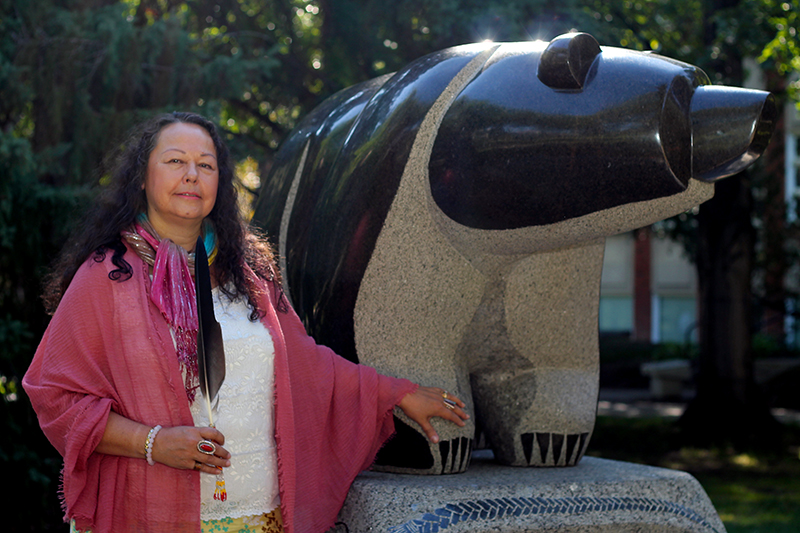Being at the crossroads and deciding between two paths is a metaphor, and a reality, that Sharla Peltier knows well. More than once she has faced a choice between two journeys, including one on the TransCanada Highway: east to Nippissing First Nation, Ont. to work as a speech pathologist and get her Master of Education, or west to Edmonton. While she chose to go to Nippissing, she still found a way to return to the University of Alberta, her alma mater for her 1986 Bachelor of Science in Speech Language Pathology. As a new faculty member in the Department of Elementary Education, focusing on language and social studies education, Peltier brings her knowledge of Anishinaabemowin and Anishinaabe pedagogy, fusing them with her experience in curriculum development and speech pathology.
"I'm really excited about the programs here," says Peltier, a Chippewa from Rama First Nation, Ontario. "There is an opportunity to look at a totally different pedagogy because the University wants native language teachers from the communities to spearhead the Indigenous languages program. We know that's going to create cultural and social economy of the language, which I think is missing."
With her rich history from working as a speech pathologist for 30 years with Wikwemikong First Nation on Manitoulin Island, with Nipissing First Nation in North Bay, and with public schools in the Sudbury area, along with Aboriginal perspectives curriculum development with Ontario's Ministry of Education, Peltier's background gives her a strong knowledge base. It is this context that she brings to the Aboriginal Teacher Education Program and to the expansion of Indigenous language education at UAlberta. As an Anishinaabemowin-learner, Peltier is excited by the growth of these programs.
"We're at a critical point", she explains.
"Anishinaabemowin, Cree, and Inuktitut are the three most likely Indigenous languages in Canada to survive, just by sheer population of those Aboriginal groups, but when we look at the number of speakers, it's dwindling. It's really, really scary. So many Aboriginal languages in Canada have been lost. There's a lot of documentation of the languages by linguists and language keepers have made dictionaries and videos to preserve the languages, but the schools are not turning out fluent speakers."
One strength Peltier sees with the Indigenous language education expansion at UAlberta is the potential for collaboration with communities and local knowledge keepers. Building capacity for Indigenous people to become teachers through the Aboriginal Teacher Education Program and for language speakers to gain university credits through the Canadian Indigenous Languages and Literacy Development Institute brings Peltier hope for the future.
"People don't see the language used in the community or they don't understand the value of it," says Peltier.
"If we have our people working together to teach it and to bring it out, then it's going to work. The issue has been that while it's been in the schools, it's been disconnected from the community. Even where I'm from, there were Anishinaabe who were in high school who aren't fluent speakers."
Gikendamowin - Gikinoo'amaagoowin
Peltier doesn't just bring a wealth of work experience to her role; she also embeds her cultural knowledge into her practice and theory. She sees her family clan-the loon- and the associated symbolism as a directive in her work.
"What I'm finding out is our clan will lead us through to find out life work in the community," she explains. "The loon flies and has a voice, so it's exciting when you think of it in that context."
For Peltier, sharing her Anishinaabe cultural knowledge and world views to education is only natural, even though traditionally-Western perspectives on education have a completely different paradigm and practice. Still, she doesn't see the two approaches as incompatible.
"There's that whole institution of education that sets up teachers to be the authority figure in the classroom and to be responsible for the children's learning and behaviour," says Peltier.
"When you're in a circle of Anishinaabe pedagogy and way of being, there is no hierarchy whatsoever; everyone is equal and each person is an important part of the process that generates new knowledge, stories and experiences. Knowledge is not a tangible thing. It's not a stack of books. It's a lived process of coming-to-know. In that way, everyone is knowledgeable and has wisdom. When we talk about how we transmit knowledge, it's through shared experience and stories. Everyone has a story, so if we bring that into our schools and institutions, it will naturally bring people together. It's inclusive as no one is excluded."
Now Peltier has the chance to share this knowledge in the classroom before the students become teachers and make a bigger impact.
"To be in this position now, and to have the opportunity to work with pre-service teachers and educate educators, I have the time, their ears and their hearts so we can start to change things up so that they realize hope - it's okay and it's going to work for everyone. This is what I've always wanted to do, and it's amazing to be here."
Knowledge - Education. Translated by Melody McKiver, Lac Seul First Nation, and Stanley Peltier, Odawa Elder and Language-Keeper.
